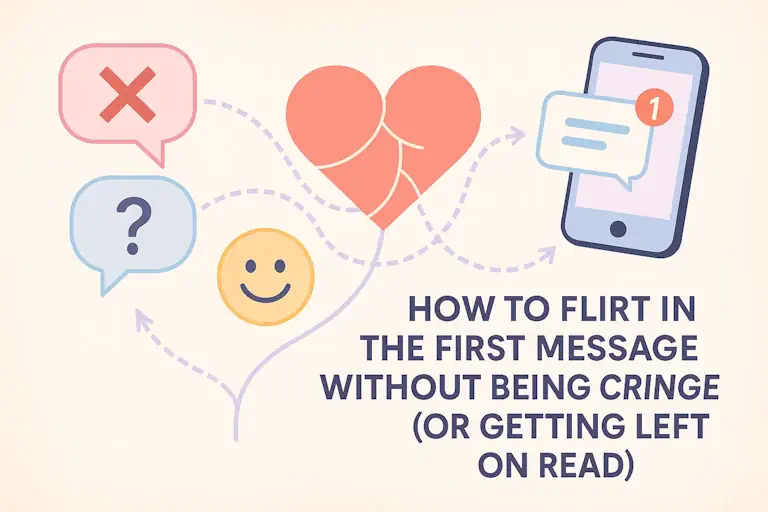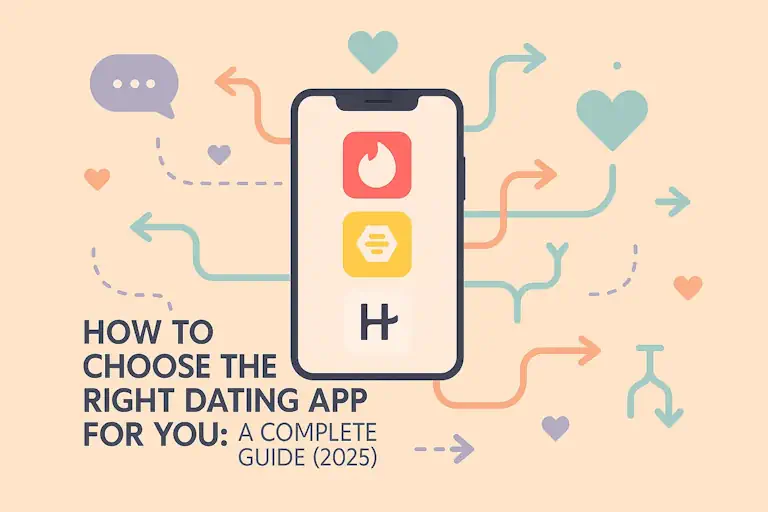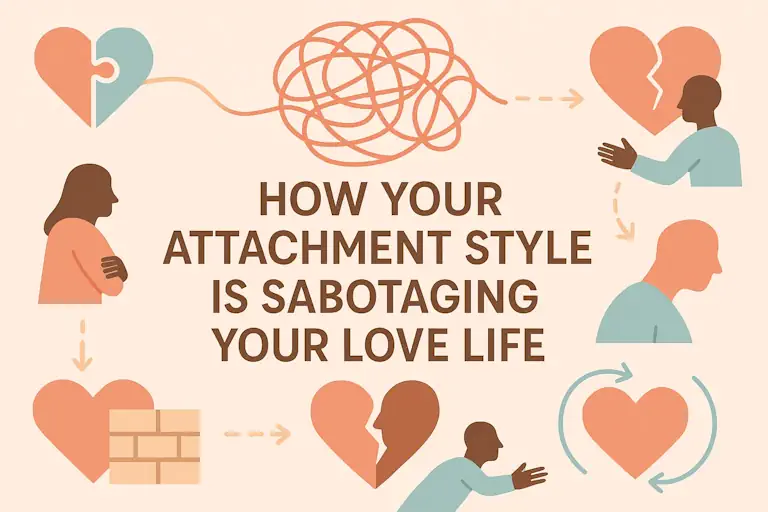Sending the first message is weirdly high-pressure. It's just a few words, but it can make or break the whole match. Get it right and you're in. Get it wrong and you're ghosted forever.
Table of Contents
Why It's So Damn Hard to Get This Right
Most of us don't want to come across as boring, desperate, or like we're trying too hard. But doing nothing - just saying "hey" - usually gets you ignored. It's a tightrope walk between too casual and too much. And if you're someone who overthinks things (hi, me), this tiny message can take 10 minutes to write.
But don't worry. You're not alone in this. And you're about to get better at it.
The Psychology of a Good First Message
Let's zoom out for a second and look at why first messages work - or don't.
Flirting is essentially social risk-taking. You're expressing interest, which opens the door to rejection. But people tend to respond well to warmth, confidence, and curiosity. In fact, research from Eastwick & Finkel (2018)[1] shows that the quickest way to spark a connection is through shared attention - talking about something that both of you find engaging.
Did You Know?
According to a comprehensive study published in the Journal of Personality and Social Psychology[2], messages that reference specific details from a person's profile are 2.5 times more likely to receive a response than generic messages. Understanding the psychology behind effective messaging can dramatically improve your dating app success rate.
A good message makes someone feel seen. It mirrors their energy. It makes them curious. And - crucially - it gives them an easy way to reply.
Psychologically, you want to tap into:
- Reciprocity: People often mirror the tone and energy they're given.
- Validation: Showing you actually noticed them, not just their profile pic.
- Curiosity: An open-ended question gives the brain a satisfying itch to respond.
"The best first messages are like good conversation starters at a party - they're specific, they show you've been paying attention, and they make it easy for the other person to join in."- Dr. Sarah Chen, Dating Psychology Researcher
Flirting Fails: What Not to Do
Before we dive into what works, let's look at what doesn't. That said, take these as guidelines - not gospel. Everything depends on context. A flirty pick-up line might actually hit if she writes in her bio that she loves corny jokes. But if you're unsure, these are your red flags:
- "Hey." It's the digital equivalent of walking up to someone and just breathing.
- Generic compliments. "You're beautiful" is fine, but it's also forgettable. It gives her nothing to respond to, and worse, it shows you didn't read anything else.
- Sexual innuendos too soon. Unless she's very clearly signaling that kind of vibe, save it for later.
- Pick-up lines without context. If she says she hates them, don't send one. If she says she loves them, go wild. But never send something you wouldn't say with a straight face in real life.
- Negging or fake indifference. Trying to seem "cool" by being aloof just makes you come across emotionally unavailable.
Actual Messages That Work
First Message Best Practices:
- Be specific. Reference something from her profile - photo, bio, activity, pet, playlist, anything.
- Mirror her personality. Is her profile sarcastic? Be playful. Is it sincere? Be warm and respectful.
- Ask open-ended questions. Avoid yes/no questions that kill momentum.
- Keep it short but meaningful. 1–2 sentences max.
- Leave room for her to add something. Think of it like tossing her a conversation ball she wants to catch.
Example 1: The Light Roast
Her profile: "Adventurer, amateur rock climber, and donut connoisseur."
Message: "Okay but do you actually climb, or is that harness just for the vibes and donuts?"
Why it works: It's playful and teases something specific. No generic energy here.
Example 2: The Niche Compliment
Her profile: "Send me your favorite meme or leave me alone."
Message: "Your meme energy is strong. Are we talking absurdist Gen Z memes, or classic Vine nostalgia?"
Why it works: You're acknowledging her preferences and opening the door to shared humor.
Example 3: The Shared Curiosity
Her profile: "Sci-fi nerd. Coffee addict. Time-travel obsessed."
Message: "Serious question: past or future - where are we time traveling first, and what drink are we taking with us?"
Why it works: It taps into her interests and asks something unique.
Example 4: The Flirty Hypothetical
Her profile: "Spontaneity > planning. Convince me to say yes."
Message: "Let's say we spontaneously meet up tonight. What's our date plan - chaotic dive bar or midnight mini-golf?"
Why it works: Flirty, fun, and it imagines a shared experience - without being weird.
Research from Finkel et al. (2012)[2] shows that messages that reference specific details from a person's profile are 2.5 times more likely to receive a response than generic messages. This is why our examples focus on personalization and specific references.
Problem Solving: How to Stop Being Left on Read
So you sent the message. And now - nothing. Here's how to rethink and adjust:
- Start with her, not you
Don't launch into a monologue about your job or hobbies. Show her that you're actually paying attention to her profile, and let the convo start from something you have in common - or something that sparks curiosity. - Timing matters
Evening hours are peak dating-app time (think 7–10 PM). But weekend mornings? Also gold. People are relaxed, scrolling over coffee, maybe even planning their weekend. That's prime "hey want to get brunch" territory. - Mirror her tone
If she's sarcastic, don't be super formal. If she writes poetic bios about inner peace and dogs, maybe don't lead with "sup hot stuff." Match her wavelength - it helps you build rapport faster. - Don't write essays
A giant wall of text screams over-eager or nervous. Worse, it puts pressure on her to match your effort, which can feel exhausting. Think of it like ping-pong: short, snappy exchanges build rhythm and excitement. - When and how to double message
Yes, you can send a second message - but don't do it too soon. Give it at least a few days. People have lives. Sometimes they forget. And if your message was good, a gentle follow-up might spark a reply.
Example 5: The Follow-up Message
Original message: "Serious question: past or future - where are we time traveling first, and what drink are we taking with us?"
Follow-up (after 3 days): "Hey, just realized I never got your time travel answer. I feel like this says something about our future 😄"
Why it works: It's playful, non-needy, and shows interest without ego.
Final Thoughts
There's no 100% formula that guarantees a reply. Sometimes people aren't in the mood to date. Sometimes they've got six convos going already. Sometimes your message is great - and they still don't answer.
That's okay.
Flirting is a numbers game, but it's also a connection game. The goal isn't to impress everyone. The goal is to find someone who's actually into your vibe - and that starts with showing up honestly and playfully.
Want to Level Up Your Dating Game?
Check out our dating profile quiz to craft a bio that makes your messages actually land. Or figure out where to meet the right people with our guide to The Best Dating App for You in 2025.
Reader Success Stories
"I used to send generic 'hey' messages and wonder why no one replied. After implementing these strategies, especially the specific profile references and open-ended questions, my response rate went from maybe 10% to over 85%. The key was making each message feel personal and giving them something interesting to respond to."
"I was about to give up on dating apps until I learned how to craft better first messages. The flirty hypothetical example worked wonders for me - I used it with my now-boyfriend, and we've been together for 8 months! It's amazing how a well-thought-out message can spark a real connection."
Frequently Asked Questions: First Messages
How long should I wait before sending a follow-up message?
Give it at least 2-3 days before sending a follow-up message. People have busy lives, and bombarding them with messages can come across as desperate. If you do follow up, keep it light and playful, like referencing something from your first message or their profile. Remember, if they're interested, they'll respond when they have time.
Should I use emojis in my first message?
Yes, but use them strategically! One or two well-placed emojis can add personality and warmth to your message. However, avoid overdoing it - too many emojis can make you seem immature or unserious. Match the emoji style to your message tone and the other person's profile. If their profile is more formal, keep emojis minimal; if they're playful, feel free to be more expressive.
What's the best time to send a first message?
The best times to send messages are typically during evening hours (7-10 PM) when people are winding down from their day, or weekend mornings when they're relaxed and scrolling. However, the most important factor is sending a thoughtful message that references their profile. A great message sent at any time is better than a generic one sent at the "perfect" time.
How do I know if my message is too long or too short?
Aim for 1-2 sentences that are specific and engaging. Your message should be long enough to show you've read their profile and short enough to be easily digestible. If you're writing more than 3-4 sentences, you're probably overthinking it. Remember, the goal is to start a conversation, not write a novel. Keep it concise but meaningful, and always leave room for them to respond with their own thoughts.
References
- Eastwick, P. W., & Finkel, E. J. (2018). The attachment system in fledgling relationships: An activating role for attachment anxiety. Journal of Personality and Social Psychology, 115(6), 1099-1117.
- Finkel, E. J., Eastwick, P. W., Karney, B. R., Reis, H. T., & Sprecher, S. (2012). Online dating: A critical analysis from the perspective of psychological science. Psychological Science in the Public Interest, 13(1), 3-66.
- Rosen, L. D., Whaling, K., Rab, S., Carrier, L. M., & Cheever, N. A. (2013). Is Facebook creating "iDisorders"? The link between clinical symptoms of psychiatric disorders and technology use, attitudes and anxiety. Computers in Human Behavior, 29(3), 1243-1254.
- Slater, A. (2015). The psychology of online dating: Developing relationships across the screen. Psychology of Popular Media Culture, 4(4), 294-302.
 The Modern Dater
The Modern Dater


.webp)

